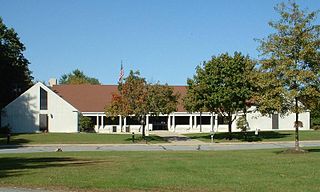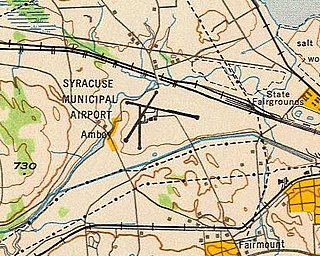Related Research Articles

Seekonk is a town in Bristol County, Massachusetts, United States, on the Massachusetts border with Rhode Island. It was incorporated in 1812 from the western half of Rehoboth. The population was 14,371 at the 2016 census. Until 1862, the town of Seekonk also included what is now the City of East Providence, Rhode Island. The land in the western half of the town was given to Rhode Island by the United States Supreme Court as part of a longstanding boundary dispute with Massachusetts.

East Providence is a city in Providence County, Rhode Island, United States. The population was 47,037 at the 2010 census, making it the fifth-largest city in the state.

Roosevelt Field is a former airport, located 2.3 miles (3.7 km) east-southeast of Mineola, Long Island, New York. Originally called the Hempstead Plains Aerodrome, or sometimes Hempstead Plains field or the Garden City Aerodrome, it was a training field for the Air Service, United States Army during World War I.

Rumford is the northern section of the city of East Providence, Rhode Island. The Rumford section of East Providence borders Seekonk, Massachusetts, Pawtucket, Rhode Island, and the Ten Mile River. Rumford has been part of three towns and two states: Rehoboth, Massachusetts, Seekonk, Massachusetts, and East Providence, Rhode Island. It became part of Rhode Island in 1862. Rumford Baking Powder was made in the town at the Rumford Chemical Works and was named after Sir Benjamin Thompson, Count Rumford.

Montgomery-Gibbs Executive Airport, formerly known as Montgomery Field and Gibbs Field, is a public airport in San Diego, California, United States, six miles (10 km) north of downtown San Diego. The airport covers 456 acres (185 ha) and has three runways, one public and two private helipads. The runways are 28 Right/10 Left-28 Left/10 Right parallels and 5/23.

Syracuse Municipal Airport was an airport located in Camillus, NY.

Moore Army Airfield is a former airfield located in Fort Devens, Massachusetts. It was closed following the closure of the fort in 1995. It is named for Ayer native Chief Warrant Officer 2 Douglas Moore. It was the only Army Airfield named for someone killed in the Vietnam War. It is currently used for racing and State Police driver training.
Stout Army Air Field is located in Indianapolis, Indiana. It serves as the Joint Forces Headquarters of the Indiana National Guard.

Eagle Pass Army Airfield is a former World War II military airfield complex. It is located 10.6 miles (17.1 km) north of Eagle Pass, Texas. It operated as a training base for the United States Army Air Forces from 1943 until 1945.
Brockton Airport was an airfield operational in the mid-20th century in Brockton, Massachusetts.
Clark Airport was an airfield operational in the mid-20th century in Hanover, Massachusetts. During the time it was closed during World War II, the Pilgrim Ordnance Works was located to the west of the airport.
Lowell Airport was an airfield operational in the mid-20th century in Lowell, Massachusetts. The airport hosted the Moth Aircraft Corp. of Lowell, where 179 de Havilland Moth planes were manufactured under license between 1929–1931.
Leicester Airport was an airfield operational in the mid-20th century in Leicester, Massachusetts.
Boston Metropolitan Airport was an airfield in Canton, Massachusetts, on the northeast side of Neponset St just southeast of the Neponset River. In the 1930s it had four gravel runways. The May 1956 sectional chart shows one 2100-ft turf runway; the airport isn't on the December 1956 chart.

Hybla Valley Airport was an airfield and flying business in the Hybla Valley area of Fairfax County, Virginia. It received Virginia's first official airport permit. The airport was used in World War II for pilot training, and was also the site of dirigible facilities.

Bekesbourne Aerodrome was an airport located at the southeast edge of the village of Bekesbourne, southeast of Canterbury, Kent. It operated from 1916 until 1940, and had both military and civil roles.

Minter Army Airfield auxiliary fields were a number of airfields used during World War II to support the Minter Army Airfield near Shafter, California. Minter Army Airfield was also called Lerdo Field, after the nearby road. Minter Army Airfield also housed the Shafter Gap Filler Annex P-59A and Shafter Army Aviation Test Activity and opened in June 1941. An Army depot open on the base in October 1941, the Minter Sub-Depot, a division of the Sacramento Air Depot. Minter Army Airfield had 7,000 troops and civilians working at the base.

Haldon Aerodrome was the first airfield in Devon. Established in the 1920s as a private flying field, it developed into an airport with scheduled airline service, and was used by the Navy during World War II. The airport has also been known as Teignmouth Airport, Little Haldon Airfield and, in its military days, RNAS Haldon and HMS Heron II.
References
- 1 2 3 "Abandoned & Little-Known Airfields: Southeastern Massachusetts". Abandoned & Little-Known Airfields. 4 September 2013. Retrieved 12 November 2017.CS1 maint: discouraged parameter (link)
- 1 2 3 4 5 6 Lennon, Frank (11 November 2017). "Twist of fate, part 1: R.I. aviation pioneer's love of flying turned his family's world upside down". The Providence Journal. Retrieved 12 November 2017.CS1 maint: discouraged parameter (link)